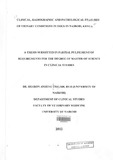| dc.description.abstract | This study aimed at evaluating the clinical, radiographic and pathological features of conditions affecting the urinary system of dogs in Nairobi, Kenya Evaluation of the prostate gland in male dogs, though a reproductive organ, was included in this study due to the fact that the urethra passes through this gland. The retrospective study involved analysis of clinical, postmortem, and histopathology records (1980-2005) from the Department of Clinical Studies and the Department of Pathology, Microbiology and Parasitology, University of Nairobi.
The prospective study involved evaluation of dogs brought to the Small Animal Clinic with a complaint related to the urinary system and those that were brought in for euthanasia Two hundred and fifty four dogs were recruited for the retrospective study of which 66.5% were males while 33.5 % were females. The German Shepherd Dog (39 %) and the cross breeds (33 %) were the most represented. In the retrospective study, nephritis was the most commonly diagnosed condition at post mortem; accounting for 78.3% of the cases with interstitial nephritis being the most common form of nephritis.
Other conditions identified were tumors (6.2 %), cystitis (4.8%), hydronephrosis (3.3%), rupture of the urinary bladder (2.4%), renal cysts (1.7%), enlarged prostate (1.4%), prostatitis (1.4 %) and renal abscesses (1.0%). The prospective study involved complete physical examination, collection of blood for hematology and biochemistry, collection of urine for urinalysis, survey and contrast radiography. Post mortem examination of all cases was carried out and samples for histopathology taken. Thirty cases were recruited; with males accounting for 63.3 % and females 36.7 %.
The German Shepherd dog was the most represented breed (58 %) followed by the cross breeds (33%). The most frequently observed clinical signs were; wasting (40 %), enlarged prostate (26.7 %) and pale mucus membranes (23.3 %). Less frequently observed findings were urinary incontinence (13.3 %), halitosis (10 %), excessive shedding of the hair coat (10 %), dehydration (6.7 %) and oral ulcers (6.7 %). Three samples of urine (10 %) had a urine specific gravity in the hyposthenuria range while two samples (6.7 %) were in the isothenuria range. Urine sediment was observed in 7 cases (23.3 %), high levels of bilirubin were observed in 7 cases (23.3 %) and blood was seen in 5 of the cases (16.7 %).
Hematology and biochemistry results were largely unremarkable; this was attributed to the reserve capacity of the kidneys that enables normal function to continue even with as few as 25% of its original nephrons. Survey and contrast radiography using Iopamidolᆴ was performed on all the cases under either deep sedation or general anesthesia The radiographs were obtained with 70-75 kV, 16-20 mAs and a focal length ofl00 cm The nephrogram and concurrently the pyelogram was poor in 23.3 % of the cases, fair in 33.3 % of the cases, good in 40 % of the cases and absent in 3.3 % of the cases. Other findings on contrast radiography were; dilated renal pelvis (10 %), shrunken kidneys (33.3 %), enlarged kidneys (20 %)~ thickened urinary bladder wall (6.7 %).
The most frequent. pathological changes included scaring and pitting of the renal surface (26.7 %), adherent renal capsule (26.7 %), urates in the bladder (23.3 %), enlarged prostate (23.3 %), thickened bladder wall (16.7 %), pale kidneys (16.7 %) and renal cysts (13.3 %). The study provides baseline data for further clinical research in canines in other parts of the country to determine the epidemiological patterns of these conditions at national level. Contrast radiography proved to be a useful aid to diagnosis and should be used more frequently as a tool for confirmatory diagnosis. The findings would be useful for dissemination to undergraduate and postgraduate studies as well as continuing professional development for small animal practitioners. | en_US |

